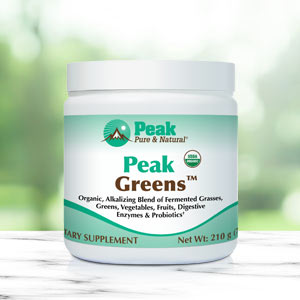Get Easy Health Digest™ in your inbox and don’t miss a thing when you subscribe today. Plus, get the free bonus report, Mother Nature’s Tips, Tricks and Remedies for Cholesterol, Blood Pressure & Blood Sugar as my way of saying welcome to the community!
Help for hay fever from an unlikely place

There have been numerous studies linking hay fever and the gut microbiome, the collection of bacteria housed there.
As weird as that may seem, it’s not all that surprising. The gut microbiome helps regulate the immune system — and short-chain fatty acids produced during digestion play an important role in that process…
Short-chain fatty acids are produced during normal digestion of dietary fiber, which includes fermentation. Their superpower? They fight inflammation.
Research has shown people with hay fever often have a less diverse gut microbiome than people who don’t suffer from seasonal allergies. That leads to an imbalanced microbiome, which goes hand in hand with inflammation — the immune system’s overreaction to harmless allergens.
Specifically, lower levels of two bacterial strains that produce short-chain fatty acids are linked with higher hay fever risk: Bifidobacterium and Lactobacillus.
The nose microbiome knows
Another player in the development of hay fever appears to be the nasal microbiome — the bacteria that populate your nose. The nose microbiome is also involved in the immune system and protects against harmful pathogens that enter the body through the nose.
An imbalanced nasal microbiome can lead to a greater risk of respiratory infections and worsening of hay fever symptoms. Investigators have found people with hay fever often have more of certain bacteria such as Staphylococcus aureus in their noses than those without the condition.
And, as is the case with the gut microbiome, this imbalance of the nasal microbiome can lead to increased inflammation and a higher risk of hay fever symptoms.
Probiotics (and prebiotics) to the rescue
Both probiotics and prebiotics are critical for maintaining a healthy gut microbiome. Probiotics are the live microorganisms that enhance the composition of “good” bacteria, and prebiotics are the fibers that these “good” bacteria feed on.
There is a growing body of research on the role of probiotics in managing hay fever. One meta-analysis of 17 studies reported various probiotic strains show significant benefits for allergic rhinitis.
Researchers exploring one strain of interest, Lactobacillus acidophilus, have found it can reduce hay fever symptoms such as itching, sneezing and congestion. Another strain, Lactobacillus rhamnosus GG, has the potential to prevent hay fever development in infants.
Another study explored the impact of a combination of Lactobacillus gasseri, Bifidobacterium bifidum and Bifidobacterium longum on hay fever. After eight weeks, results showed people taking the combination probiotic had fewer allergy-related nasal symptoms and were better able to function in their daily lives.
There are other strains such as Bifidobacterium lactis and Lactobacillus casei that have shown promise in relieving hay fever symptoms. However, further research is needed.
Probiotics appear to work by decreasing production of inflammatory cytokines that immune cells fire out when they sense an invader. Often times with allergies or autoimmune conditions the immune system response goes a little overboard.
But Lactobacillus acidophilus, for example, can lower the expression of inflammatory cytokines connected with allergic inflammation in the nasal cavity’s mucous membranes. And Lactobacillus rhamnosus GG has shown the ability to reduce excessive narrowing of the airway, decrease inflammatory cells in the lungs, and lower inflammatory cytokines.
Prebiotics like fructo-oligosaccharides have also been studied for their potential to prevent hay fever, since they’ve been found to increase beneficial Bifidobacterium and Lactobacillus gut bacteria. In one study in infants, fructo-oligosaccharides supplementation lowered the risk of developing hay fever.
Getting the right probiotics and prebiotics
Given how good prebiotics and probiotics are for you, it’s a great idea to incorporate foods containing these beneficial fibers and bacteria into your diet even if you don’t suffer from hay fever.
For probiotics, you’ll want to add fermented foods such as yogurt, kefir, kimchi, miso, tempeh, sauerkraut and kombucha. And the prebiotics known as fructo-oligosaccharides can be found in a wide range of plants including asparagus, artichokes, bananas, chicory, garlic, jicama, leeks, nectarines, onions, papaya and whole grains.
If you do suffer from hay fever like me, you may want to make sure you’re getting the specific probiotics that have shown promise in relieving your symptoms. For instance, many of the studied Lactobacillus and Bifidobacterium strains can be found in fermented foods, particularly yogurt, miso and tempeh.
If choosing to supplement, look for a probiotic with lots of different strains. And it’s a bonus if the supplement also contains prebiotics.
Editor’s note: Did you know that when you take your body from acid to alkaline you can boost your energy, lose weight, soothe digestion, avoid illness and achieve wellness? Click here to discover The Alkaline Secret to Ultimate Vitality and revive your life today!
Sources:
Keeping Hay Fever in Check May Be as Easy as Maintaining These Two Microbiomes — ScienceAlert
Functional and nutraceutical properties of fructo-oligosaccharides derivatives: a review — International Journal of Food Properties
Lactobacillus acidophilus — Mount Sinai
Lactobacillus Rhamnosus 101: Sources, Benefits, and Uses — Physician’s Choice
Lactobacillus gasseri: A Healthy Probiotic Strain — Global Healing
Bifidobacterium Bifidum: Benefits, Side Effects, and More — Healthline
What Are The Different Types Of Probiotics? — wildbrine














